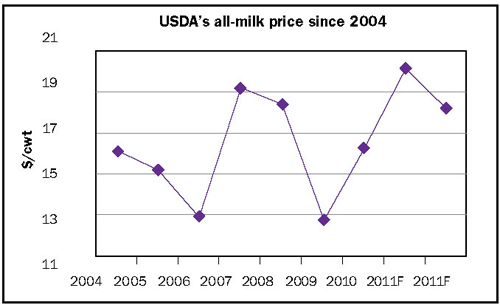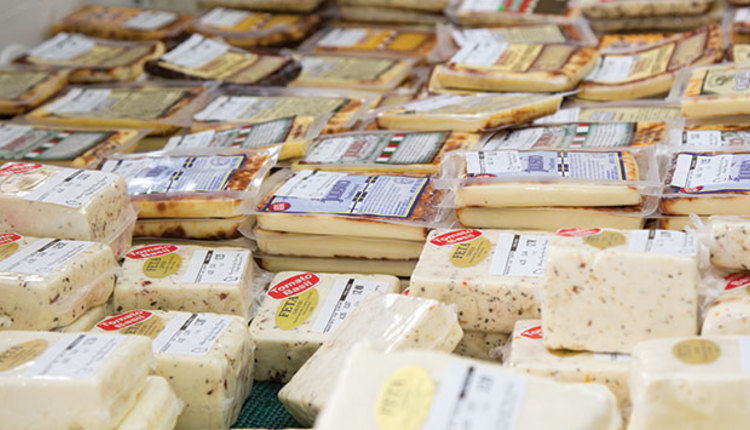The author is principal of Keough Ledman Associates, Inc., Libertyville, Ill.
As Halloween approaches, we are all wondering if 2012 milk prices will be a "trick" or a "treat."
The "trick" would be a continuation of the three-year milk price cycle - two years of good milk prices followed by a year of low prices. For example, U.S. all-milk prices averaged $16.13 and $15.19 in 2004 and 2005 followed by $12.96 in 2006. More recently in 2007 and 2008, all-milk prices averaged $19.21 and $18.45 followed by the disastrous 2009 low price of $12.83.

If USDA predictions for 2012 turn out to be correct, the three-year cycle could be broken which would be the "treat." USDA's September 2011 estimate for the 2012 all-milk price is between $17.80 and $18.80. That compares to the beginning of the latest three-year cycle which begins with a $16.29 all-milk price in 2010 and the projected $20.25 for this year.
Time for a review
It is prudent to review USDA's price forecast in the years just prior to the downturns. In October 2005, USDA forecast the 2006 all-milk price between $13.35 to $14.25. Three years later, USDA forecast the 2009 price ranging from $16.50 to $17.40. In both cases, USDA's forecasts were more optimistic than the final outcome by 84 cents for 2006 and by $4.12 for 2009.
Furthermore, Class III futures in both years offered an opportunity to lock in Class III prices for more than $1 per hundredweight (cwt.) above Class III in 2006 and over $4 higher than 2009's Class III prices.
At the moment, Class III futures for 2012 (as of mid-September 2011) averaged $17.13 per cwt. Granted, that is about $1 less than the expected average Class III price for 2011. However, it would still rank as one of the four highest annual Class III prices in history.
So, what supply and demand factors exist that could either swing prices higher or lower?
Fortunately for U.S. dairy producers, global dairy product demand has remained robust. U.S. dairy exports trended lower in July 2011 versus the prior month but continue to outpace 2010's overall level by a significant margin.
On a volume basis, nonfat dry milk/skim milk powder (NFDM/SMP) leads the way with 562.6 million pounds exported through July. That's up 36 percent compared with last year and accounts for 48 percent of NFDM/SMP production.
Through July, butter and milkfat exports totaled 99.3 million pounds, a 37 percent gain, and represents 9.3 percent of total butter production.
Commercial exports of cheese and curd are likely to post a record high in 2011. Through July, total cheese exports are 300 million pounds, up 41 percent versus last year. They account for almost 5 percent of total cheese production. Total year-to-date export value for the first seven months of 2011 is $2.707 billion, a 33 percent jump over the same period last year.
Stronger exports boosted commercial disappearance through July 2011 to 1.5 percent over previous-year levels. During this period, commercial disappearance of butter (+8.8 percent), American cheese (+3.4 percent), and other cheese (+6.1 percent) rose, while sales of nonfat dry milk (-4.4 percent) and fluid milk products (-1.6 percent) fell.
Rising consumer prices in Europe and the United States along with sluggish job markets and declining real wages have resulted in building domestic dairy product inventories in both regions. These stocks are now competing for export markets. In particular, the exceptionally strong export volumes in 2010 to Russia, the Middle East, and China may be difficult to match in 2011. As a result, global dairy product prices are expected to ease through 2011's fourth quarter.
Production could slow
Just how far global dairy product prices ease depends in part on the growth of the world's milk supply. Milk production growth in Europe and the U.S. slowed in the second half of 2011. In particular, hot, dry weather during the summer has reduced European production growth. Rising feed costs, lower milk prices, and quota considerations are likely to mitigate production growth early next year.
According to USDA's Milk Production report for August, U.S. milk production topped 16.4 billion pounds, 2.1 percent more than last August. Greater milk production was driven by a 1.1 percent gain in milk per cow and a 94,000-head gain in the dairy herd (+1.0 percent). Since January, the dairy herd grew by 59,000 head: California was up 23,000; Washington added 13,000; Texas gained 10,000; Idaho grew by 9,000; and New Mexico added 7,000 milk cows.
In for a repeat?
So, what's different today that could lessen the likelihood of the three-year cycle repeating itself and causing a price collapse?
During the unprecedented high milk prices of 2008 and 2009, the U.S. dairy herd grew by more than 200,000 head from 9.129 to 9.334 million head. From 2010 through August 2011, the U.S. dairy herd rose by 128,000 to 9.217 million head. Milk production per cow in 2007 and 2008 climbed by 2.1 percent and 2.3 percent, respectively. In 2010 and 2011, milk per cow grew less than 1.5 percent, compared to the prior year.
It appears the industry could be bearish on milk production growth in 2012 due to rising corn, soybean, and alfalfa prices due both to quality and availability of supply. However, milk produced in countries less dependent on corn, soybeans, and alfalfa will not face the same constraints.
Global dairy markets have continued to expand since 2008. In particular, Mexico, China, South Korea, and Vietnam are vibrant markets for the U.S. However, growing global milk production in the Southern Hemisphere, U.S., and Europe, relative to domestic demand, is likely to intensify competition for global markets.
In my opinion, a Class III milk price of $17 would be a treat in 2012. Barring unforeseen climatic conditions, there appears to be more downside than upside price risk.
Risk management programs can reduce uncertainty. If producers were to lock in a milk price and a margin for at least a portion of their milk production, they no longer would need to fret about what tricks October might hold.
As Halloween approaches, we are all wondering if 2012 milk prices will be a "trick" or a "treat."
The "trick" would be a continuation of the three-year milk price cycle - two years of good milk prices followed by a year of low prices. For example, U.S. all-milk prices averaged $16.13 and $15.19 in 2004 and 2005 followed by $12.96 in 2006. More recently in 2007 and 2008, all-milk prices averaged $19.21 and $18.45 followed by the disastrous 2009 low price of $12.83.

If USDA predictions for 2012 turn out to be correct, the three-year cycle could be broken which would be the "treat." USDA's September 2011 estimate for the 2012 all-milk price is between $17.80 and $18.80. That compares to the beginning of the latest three-year cycle which begins with a $16.29 all-milk price in 2010 and the projected $20.25 for this year.
Time for a review
It is prudent to review USDA's price forecast in the years just prior to the downturns. In October 2005, USDA forecast the 2006 all-milk price between $13.35 to $14.25. Three years later, USDA forecast the 2009 price ranging from $16.50 to $17.40. In both cases, USDA's forecasts were more optimistic than the final outcome by 84 cents for 2006 and by $4.12 for 2009.
Furthermore, Class III futures in both years offered an opportunity to lock in Class III prices for more than $1 per hundredweight (cwt.) above Class III in 2006 and over $4 higher than 2009's Class III prices.
At the moment, Class III futures for 2012 (as of mid-September 2011) averaged $17.13 per cwt. Granted, that is about $1 less than the expected average Class III price for 2011. However, it would still rank as one of the four highest annual Class III prices in history.
So, what supply and demand factors exist that could either swing prices higher or lower?
Fortunately for U.S. dairy producers, global dairy product demand has remained robust. U.S. dairy exports trended lower in July 2011 versus the prior month but continue to outpace 2010's overall level by a significant margin.
On a volume basis, nonfat dry milk/skim milk powder (NFDM/SMP) leads the way with 562.6 million pounds exported through July. That's up 36 percent compared with last year and accounts for 48 percent of NFDM/SMP production.
Through July, butter and milkfat exports totaled 99.3 million pounds, a 37 percent gain, and represents 9.3 percent of total butter production.
Commercial exports of cheese and curd are likely to post a record high in 2011. Through July, total cheese exports are 300 million pounds, up 41 percent versus last year. They account for almost 5 percent of total cheese production. Total year-to-date export value for the first seven months of 2011 is $2.707 billion, a 33 percent jump over the same period last year.
Stronger exports boosted commercial disappearance through July 2011 to 1.5 percent over previous-year levels. During this period, commercial disappearance of butter (+8.8 percent), American cheese (+3.4 percent), and other cheese (+6.1 percent) rose, while sales of nonfat dry milk (-4.4 percent) and fluid milk products (-1.6 percent) fell.
Rising consumer prices in Europe and the United States along with sluggish job markets and declining real wages have resulted in building domestic dairy product inventories in both regions. These stocks are now competing for export markets. In particular, the exceptionally strong export volumes in 2010 to Russia, the Middle East, and China may be difficult to match in 2011. As a result, global dairy product prices are expected to ease through 2011's fourth quarter.
Production could slow
Just how far global dairy product prices ease depends in part on the growth of the world's milk supply. Milk production growth in Europe and the U.S. slowed in the second half of 2011. In particular, hot, dry weather during the summer has reduced European production growth. Rising feed costs, lower milk prices, and quota considerations are likely to mitigate production growth early next year.
According to USDA's Milk Production report for August, U.S. milk production topped 16.4 billion pounds, 2.1 percent more than last August. Greater milk production was driven by a 1.1 percent gain in milk per cow and a 94,000-head gain in the dairy herd (+1.0 percent). Since January, the dairy herd grew by 59,000 head: California was up 23,000; Washington added 13,000; Texas gained 10,000; Idaho grew by 9,000; and New Mexico added 7,000 milk cows.
In for a repeat?
So, what's different today that could lessen the likelihood of the three-year cycle repeating itself and causing a price collapse?
During the unprecedented high milk prices of 2008 and 2009, the U.S. dairy herd grew by more than 200,000 head from 9.129 to 9.334 million head. From 2010 through August 2011, the U.S. dairy herd rose by 128,000 to 9.217 million head. Milk production per cow in 2007 and 2008 climbed by 2.1 percent and 2.3 percent, respectively. In 2010 and 2011, milk per cow grew less than 1.5 percent, compared to the prior year.
It appears the industry could be bearish on milk production growth in 2012 due to rising corn, soybean, and alfalfa prices due both to quality and availability of supply. However, milk produced in countries less dependent on corn, soybeans, and alfalfa will not face the same constraints.
Global dairy markets have continued to expand since 2008. In particular, Mexico, China, South Korea, and Vietnam are vibrant markets for the U.S. However, growing global milk production in the Southern Hemisphere, U.S., and Europe, relative to domestic demand, is likely to intensify competition for global markets.
In my opinion, a Class III milk price of $17 would be a treat in 2012. Barring unforeseen climatic conditions, there appears to be more downside than upside price risk.
Risk management programs can reduce uncertainty. If producers were to lock in a milk price and a margin for at least a portion of their milk production, they no longer would need to fret about what tricks October might hold.









